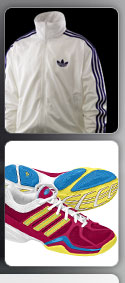“Story of technical excellence”

Super grip (1964)
The super grip first appearing in 1964 was the forerunner to the superstar and shares many of the instantly recognizable characteristics that gave the historic shell toe the status of cultural icon that’s still ongoing today.
Featuring a plain sock liner, harder leather synthetic lining in the heels cushioned insoles and multifunctional tread soles, the super grip was relatively technically advanced compared to the other models at the time and quickly established itself in the market due to its high level of versatility.
Even after the introduction of its big brother the superstar the shoe continued to sell well as and affordable alternative to its more expensive shell toed successor.
The model displayed here is the earliest known incarnation of the super grip and displays all the legendary characteristics of the model.
Samba (1965)
Originally introduced in 1962, the samba was the first football-training shoe developed specifically for frozen pitches but quickly evolved to become the dominant indoor football shoe for player’s world wide.
The samba pictured here is from circa 1965 and features a distinctive toe guard, sleek kid leather, lower stitching on the side of the sole and shoehorn, leather lining in the heels cushioned insoles and clip for the laces. Another technical highlight was the holes cut from the soles of the shoe to provide greater traction on indoor football shoe.
This level of detailing ensured the ongoing popularity of the shoe and the samba is still arguably the most recognizable football silhouette in the world.
The samba has gone on to outgrow its original purpose as a training shoe earning a special relevance among the football fan culture and becoming a modern day street classic in its own right.
Tokio (1966)
Initially conceived and intended as a reasonably priced school sports shoe, the Tokio quickly became thought of as a leisure shoe and rapidly gained a following among both the style conscious and fashion led.
The tokio was part of the “6-v”series that also included notable models like the Japan hobby and Nippon.
The bootleg model pictured is constructed from surface calf leather and has simple lining, keeping in line with the minimal aesthetics of the model. The vulcanized outer sole with the minimal Aesthetics of the model. The vulcanized outer sole is made from a durable rubber and the model pictured features a border that is not present in later models.
Spezial (1968)
Coinciding with the dawn of the open era was a rise in the number of artificial surfaces that games of the tennis were being played on. This led to seek out the services of current world number 1, Rod Laver to develop a shoe that could stand up to the rigors of the new surfaces and the beginnings of the Spezial were born.
The bootleg pictured is an early developed model and features an upper constructed of a permeable mesh for maximum breathability and toe box and tongue made of smooth leather to ensure comfort.
The outsole and midsole are both constructed from a durable rubber to provide maximum traction on the new synthetic surfaces that were coming into play.
Laver continued to test the shoes and push further development of the Spezial with the final result being the launch of his own rod laver collection in 1970.
Superstar (1969)
Created by Adi Dassler and introduced in 1969,the superstar was the first low top basketball shoe to feature an all-leather and the infamous rubber shell toe.
Based on its successful predecessor, the super grip, the superstar quickly gained acclaim with NBA players and by the mid 70s nearly three quarters of the leagues ball players had swapped their canvas shoes in favor of the new leather shell toe from adidas.
Featured a plain sock liner, cushioned insoles dropped stitching on the midsole the now ubiquitous rubber shell toe and multifunctional tread soles, the superstar quickly began to establish itself off the court as well, gradually evolving into the cultural fixtures and timeless icon that it has become today.
The superstar pictured here is the earlier example of the iconic shoe that adidas have in the scheinfeld archive.
Gazelle (1969)
When the gazelle first appeared in 1969 the silhouette prompted some initial confusion, as the shape of the shoe seemed equally suited to both indoor soccer and running. General consensus had the gazelle pegged as an athletic training shoe but one thing that has never been In question is the versatility and overall comfort of the model.
The Gazelle had a slew of features a the time of its introduction including harder leather, a suede upper, lower stitching on both the sole and tongue, synthetic lining in the heel and a multifunctional tread sole. These features combined with suede upper and streamlined wedge shape for stylish, highly functional shoes.
The prototype version pictured here is from 1969 and includes a zipper on the side of the shoe that allowed for both a quick change and ideal fit.
Nizza (1976)
Robust, double shifted canvas material with foam rubber cushion in the ankle and an eyelet for better air ventilation, molded transparent soles. The original Nizza featured a canvas upper, half rubber toecap and a round silhouette imbuing the shoe with a clean effortless style.
Primary developed as a well price shoe model for sport and leisure time activities, the Nizza also established as a basketball shoe in the 70s.
The Nizza is one of those rare styles that managed to capture the imagination of a wide range of sub-cultures. With a touch of punk a hint of mod and a sparkle of skater-inspired flare it is one of those styles that’s as unique as the person who wears it.
Spezial (1977)
Around the year of 1977 adidas began looking into the problems associated with the sliding and abrasive properties of tennis shoes.
The boot pictured, an adaption of spezial,is one of several prototypes developed to try and develop a solution to the issue. The combined findings led to the development of a very successful product group, the “tennis-court”
In addressing the issue with grip, the Stan smith outer sole was adapted and the rubber pinches taken out with the exception of the heel and toe and replaced with the ultra durable, hardened rubber.
ATP indoor tennis shoe (1980)
The beginning of the 80s saw a market rise in the popularity of indoor-tennis tournaments and a shoe was needed that allowed players full flexibility on the new surfaces.
The ATP indoor tennis tournament and a shoe were needed that allowed players full flexibility on the new surfaces. The ATP indoor tennis-so named as it was both tested and approved by the association of tennis professionals was the indoor version of the ATP outdoor performance tennis shoe.
The combination upper features a mix of nylon mesh for ventilation, full grain leather in the heel for support and suede leather covering the toecap for added protection.
The full shell rubber outsole provided superior grip and durability by utilizing a special tread that was specially designed to work on synthetic surfaces.
Top Ten Canvas hi (1983)
Introduced as a leisure interpretation of the well-known top ten Hi, this canvas edit reserved the hi tech approach and mechanical functions in favor of performance and comfort through the choice of material and shape of the silhouette.
The all canvas upper is set off with a transparent rubber sole with all while foxing details, leading o a more toned down, subtle version of its famous relative.
Prototypes of APS (1984)
The development of the antipronation and shock absorption (A.P.S) system began in 1984 and was developed in conjunction with leading specialists in creating suspension system at the time. Fichtel and sachs. The model pictured shows one of the earliest prototypes of the APS Technology incorporated into an existing 1980 TRX training model.
The ideas and technology that went into this prototype foreshadowed the cushioning system in the adidas that was introduced later in 2004 two decades later. Further testing and development led to the introduction of the first APS shoe that went into production in 1985.
As you turned the key, gap within the cushioning elements were compressed creating a stiffer, more responsive ride. Turning the key back, the cushioning properties felt softer and more comfortable meaning the shoe could be adapted to suit individual runners and their respective styles.
APS (1985)
The A.P.S (Antipronation shock absorption system) was first running and training shoe to feature customized cushioning.
This patented technology was developed in conjunction with fichtel and Sachs and was made visible through a window in the heel area. The system allowed the athletes to adjust the shock absorption of the midsole to suit to suit his or her body weight and ground conditions.
The cassette incorporated into the outsole contained PU rods suspended from a TPU shaft. Using a especially designer key, runners could set the heel cushioning to suit their individuals preferences and the specific running surface, to achieve a smoother and more stable ride.
Turning the key clockwise draw the rods together, making the midsole harder, and turning the key anticlockwise made it softer.
The set absorption level was checked through the visible window in the heel. And as some runners
‘overpronated”, that is the turned too much to the inside with their feet upon landing, the rods to achieve a more stable and supportive running stride.
ZX -8000 (1989)
The introduction of torsion technology two decades ago made an instant impact with runners worldwide and was incorporated into a range of models almost immediately after its introduction. Development in conjunction with a scientific institute, the torsion bar was designed to support the midfoot and facilitate a greater range of movement as well as reducing the volume of midsole material requird for construction in a lighter shoe.
The ZX 8000, Introduced in 1989 was the first shoe to take advantage of the new torsion technology and in doing so cemented its position as one of the most iconic running shoes of all time.
The bootleg model pictured is an early prototype and features triple shifted nylon, harder leather and lower stitching on the side of the sole and tongue, a multifunctional tread sole and a PUR midsole complete with new Torision.
The bootleg model pictured is an early prototype and features triple shifted nylon, harder leather and lower stitching on the side of the sole and tongue, a multifunctional tread sole and a PUR midsole complete with new torsion system that seemed beneficial in aiding improvement of individual running techniques.
Many of the features on the prototype made it through to the final version, including the acclaimed color way that still pops up on modern reedits of the original.
Since its initial release over 20 years ago the ZX 8000 has transcended its original inception as a performance shoe and evolved into one of the most influential lifestyles models ever produced.
Unreleased prototype
As early as 1970 Adi Dassler and his development team were thinking about a shoe that you could kick around a corner with so it perhaps comes as little surprise that the bootleg pictures somewhat resembles the modern ay ‘predator.’
Features included lacing that ran asymmetrically to the outside and real sharkskin was included on the instep of the boot.
Testing with the prototype was successful and footballs kicked with the booth were impaired with a fantastic spin.
Unfortunately the sharkskin also damaged the leather footballs that were ubiquitous at the time so the model never made it into production. |






